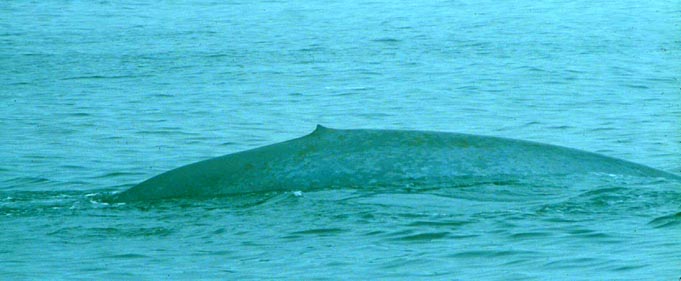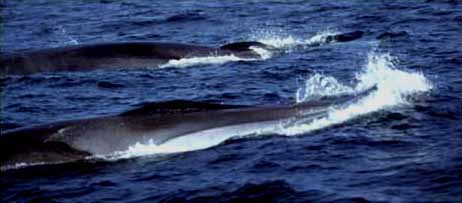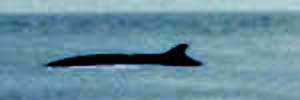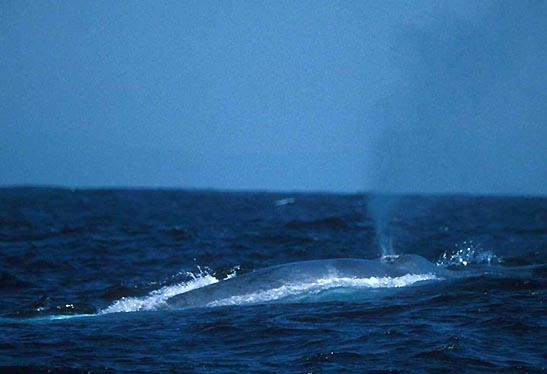 MONTEREY BAY BALEEN WHALES I:
Blue, Fin, Sei, and Minke whales
MONTEREY BAY BALEEN WHALES I:
Blue, Fin, Sei, and Minke whales
 "Thar she blows!" There is nothing quite like that shout to wake up a boatload
of nodding sea-goers. In Monterey Bay in late summer and early fall, that
blow is often a Blue Whale Balaenoptera musculus. The largest
mammal ever to exist on earth, large Blue Whales can run up to a hundred
feet in length (although the average is about 80-90 feet long). Their spout
is powerful and can be seen for miles. Although still endangered world-wide,
here in Monterey Bay there is a regular summer and fall passage that brings
these huge mammals close to shore, and, given decent weather, one can almost
be guaranteed an observation from a whale-watching trip. A fine experience
may begin with the blow on the horizon (above) and end with close views
of a tail fluke of a shallow diving giant (right).
"Thar she blows!" There is nothing quite like that shout to wake up a boatload
of nodding sea-goers. In Monterey Bay in late summer and early fall, that
blow is often a Blue Whale Balaenoptera musculus. The largest
mammal ever to exist on earth, large Blue Whales can run up to a hundred
feet in length (although the average is about 80-90 feet long). Their spout
is powerful and can be seen for miles. Although still endangered world-wide,
here in Monterey Bay there is a regular summer and fall passage that brings
these huge mammals close to shore, and, given decent weather, one can almost
be guaranteed an observation from a whale-watching trip. A fine experience
may begin with the blow on the horizon (above) and end with close views
of a tail fluke of a shallow diving giant (right).
The Blue Whale, like all the other whales discussed on this page, is
a baleen whale with a dorsal fin (a second page, linked at the bottom,
discusses the two local baleens without dorsal fins ? Humpback and Gray).
Baleen whales have many strands of baleen instead of teeth which they use
to strain out tons of plankton from sea water. Expandable grooves on the
throat allow them to take in huge amounts of water to be processed. The
largest of these baleen whales — the Blue, Fin, and Sei — are collectively
known as roquals.
All the roquals on this page have proportionately small dorsal fins
(another roqual — Humpback Whale — has only a dorsal bump). The the tiniest
dorsal fin belong to the Blue Whale. It is set 3/4 of the way back along
the body. When a Blue Whale is surfacing, it often seems like the back
just keeps going and going and going and going until the tiny fin finally
appears.
|
|
At close distances, one can see the huge double blowholes near the
tip of the snout (left). The snout of Blue Whale is broad and rounded,
unlike the more pointed snouts of Fin and Sei Whales. |
|
Blue Whales really are a blue-gray color, but lighting can effect
how they look. Compare one photographed on a bright sunny day (above) with
one on an overcast day (right). The body is mottled with lighter patches
among the gun-blue color.
|
 |
 While Blue Whales are regular in Monterey Bay, the slightly smaller Fin
Whale Balaenoptera physalus (left) is erratic in very small
numbers. There are other places on earth (e.g., off eastern Canada) where
Fin Whale is the expected roqual, but not here. They can be large whales
— averaging 60-65 feet in length — but are more streamlined with a pointed
snout and less powerful blow. The recurved dorsal fin is much more prominent
that on Blue Whale, and the entire whale is usually quite slaty-gray in
color; they often look black at a distance. I once was aboard a boat that
found a Fin Whale feeding in Monterey Bay. It would sink below the surface
below a patch of plankton, blow a circular "net" of bubbles around them
to hold them in place, and then come charging up to the surface, mouth
agape, to take in as many as possible. Very impressive!
While Blue Whales are regular in Monterey Bay, the slightly smaller Fin
Whale Balaenoptera physalus (left) is erratic in very small
numbers. There are other places on earth (e.g., off eastern Canada) where
Fin Whale is the expected roqual, but not here. They can be large whales
— averaging 60-65 feet in length — but are more streamlined with a pointed
snout and less powerful blow. The recurved dorsal fin is much more prominent
that on Blue Whale, and the entire whale is usually quite slaty-gray in
color; they often look black at a distance. I once was aboard a boat that
found a Fin Whale feeding in Monterey Bay. It would sink below the surface
below a patch of plankton, blow a circular "net" of bubbles around them
to hold them in place, and then come charging up to the surface, mouth
agape, to take in as many as possible. Very impressive!
|
As this Fin Whale (right) arches up to dive, note how blackish
the body color is, and note the relative proportions of the dorsal fin.
This angle precludes estimating the angle of the dorsal fin, but in the
photo of the same whale (above) note that the angle of the fin is less
than 45° from the body.
|

|
|
Compare the body color and dorsal fin proportions of the Sei
Whale Balaenoptera borealis (right). It is slightly smaller
than Fin Whale, and averages about 45-50 feet in length. It has a slightly
larger and often more upright dorsal fin (making a 45° angle or more
with back), and its body color tends to run to the brownish side of gray.
It is by far the rarest roqual locally and tends to be found farther offshore.
In 30 years of sea-birding on Monterey Bay, I have only seen 2 Sei Whales
(and one more off Morro Bay). My observations are between October-February.
|

|
 Separating Fin Whale from Sei Whale can be difficult unless one gets a
good view of the right jaw. Both species have white to the lower jaw but
on Fin Whale that white expands to include the entire lower jaw and part
of the upper jaw, making an obvious white patch on the right side of the
face as the whale surfaces. This is seen very nicely in Richard Ternullo's
fine shot of two Fin Whales (left). It is important to get
the view of the whale emerging, as the white patch is soon lost below the
surface after the blow is completed (note the back whale in Richard's shot).
On the Sei Whale (above) that Richard and I identified in October
2002, we could see no white on the right side of the jaw when Richard positioned
the boat to give us those critical views.
Separating Fin Whale from Sei Whale can be difficult unless one gets a
good view of the right jaw. Both species have white to the lower jaw but
on Fin Whale that white expands to include the entire lower jaw and part
of the upper jaw, making an obvious white patch on the right side of the
face as the whale surfaces. This is seen very nicely in Richard Ternullo's
fine shot of two Fin Whales (left). It is important to get
the view of the whale emerging, as the white patch is soon lost below the
surface after the blow is completed (note the back whale in Richard's shot).
On the Sei Whale (above) that Richard and I identified in October
2002, we could see no white on the right side of the jaw when Richard positioned
the boat to give us those critical views.
 The
smallest of the baleen whales is the Minke Whale Balaenoptera
acutorostrata. It is quite small — only 21-28 feet in length — and
surfaces only briefly (right, in a video cap in Aug 2000 by Vladimir
Dinets). It often hugs the shoreline; Pt. Pinos is a particularly good
spot to see one, especially in summer and fall. Minke Whale is a fast-moving
roqual and surfaces only briefly — the light blow and dorsal fin are seen
simultaneously. Note that its dorsal fin is much larger in proportion to
its size than in the large roquals. Minke Whale — like the other species
on this page — are found in temperate and tropical oceans around the world.
The
smallest of the baleen whales is the Minke Whale Balaenoptera
acutorostrata. It is quite small — only 21-28 feet in length — and
surfaces only briefly (right, in a video cap in Aug 2000 by Vladimir
Dinets). It often hugs the shoreline; Pt. Pinos is a particularly good
spot to see one, especially in summer and fall. Minke Whale is a fast-moving
roqual and surfaces only briefly — the light blow and dorsal fin are seen
simultaneously. Note that its dorsal fin is much larger in proportion to
its size than in the large roquals. Minke Whale — like the other species
on this page — are found in temperate and tropical oceans around the world.
PHOTOS: All
photos on this page are © 2002 Don Roberson, and were taken over the
last 20 years, except the Fin Whale duo © Richard Ternullo (he took
that photo in late 1997) and the Minke Whale video-cap by Vladimir Dinets.
All photos are from Monterey Bay or offshore Monterey County.
MORE INFORMATION:
More details about Monterey Bay's large whales is on the Monterey
Bay Whale Watch site. Vladirmir Dinets' web site also has more information
on worldwide whales.
Click on the links below to bring up the photo-intensive pages which
feature:
TOP
BACK TO HOME
PAGE
GO TO MONTEREY
BAY PAGE
GO TO MONTEREY
COUNTY PAGE
GO TO MAMMALS
PAGE
GO TO BIRDING THE
WORLD PAGE
GO TO BIRD FAMILIES
OF THE WORLD
Page created 2-13 Nov 2002


 "Thar she blows!" There is nothing quite like that shout to wake up a boatload
of nodding sea-goers. In Monterey Bay in late summer and early fall, that
blow is often a Blue Whale Balaenoptera musculus. The largest
mammal ever to exist on earth, large Blue Whales can run up to a hundred
feet in length (although the average is about 80-90 feet long). Their spout
is powerful and can be seen for miles. Although still endangered world-wide,
here in Monterey Bay there is a regular summer and fall passage that brings
these huge mammals close to shore, and, given decent weather, one can almost
be guaranteed an observation from a whale-watching trip. A fine experience
may begin with the blow on the horizon (above) and end with close views
of a tail fluke of a shallow diving giant (right).
"Thar she blows!" There is nothing quite like that shout to wake up a boatload
of nodding sea-goers. In Monterey Bay in late summer and early fall, that
blow is often a Blue Whale Balaenoptera musculus. The largest
mammal ever to exist on earth, large Blue Whales can run up to a hundred
feet in length (although the average is about 80-90 feet long). Their spout
is powerful and can be seen for miles. Although still endangered world-wide,
here in Monterey Bay there is a regular summer and fall passage that brings
these huge mammals close to shore, and, given decent weather, one can almost
be guaranteed an observation from a whale-watching trip. A fine experience
may begin with the blow on the horizon (above) and end with close views
of a tail fluke of a shallow diving giant (right).


 While Blue Whales are regular in Monterey Bay, the slightly smaller Fin
Whale Balaenoptera physalus (left) is erratic in very small
numbers. There are other places on earth (e.g., off eastern Canada) where
Fin Whale is the expected roqual, but not here. They can be large whales
— averaging 60-65 feet in length — but are more streamlined with a pointed
snout and less powerful blow. The recurved dorsal fin is much more prominent
that on Blue Whale, and the entire whale is usually quite slaty-gray in
color; they often look black at a distance. I once was aboard a boat that
found a Fin Whale feeding in Monterey Bay. It would sink below the surface
below a patch of plankton, blow a circular "net" of bubbles around them
to hold them in place, and then come charging up to the surface, mouth
agape, to take in as many as possible. Very impressive!
While Blue Whales are regular in Monterey Bay, the slightly smaller Fin
Whale Balaenoptera physalus (left) is erratic in very small
numbers. There are other places on earth (e.g., off eastern Canada) where
Fin Whale is the expected roqual, but not here. They can be large whales
— averaging 60-65 feet in length — but are more streamlined with a pointed
snout and less powerful blow. The recurved dorsal fin is much more prominent
that on Blue Whale, and the entire whale is usually quite slaty-gray in
color; they often look black at a distance. I once was aboard a boat that
found a Fin Whale feeding in Monterey Bay. It would sink below the surface
below a patch of plankton, blow a circular "net" of bubbles around them
to hold them in place, and then come charging up to the surface, mouth
agape, to take in as many as possible. Very impressive!


 Separating Fin Whale from Sei Whale can be difficult unless one gets a
good view of the right jaw. Both species have white to the lower jaw but
on Fin Whale that white expands to include the entire lower jaw and part
of the upper jaw, making an obvious white patch on the right side of the
face as the whale surfaces. This is seen very nicely in Richard Ternullo's
fine shot of two Fin Whales (left). It is important to get
the view of the whale emerging, as the white patch is soon lost below the
surface after the blow is completed (note the back whale in Richard's shot).
On the Sei Whale (above) that Richard and I identified in October
2002, we could see no white on the right side of the jaw when Richard positioned
the boat to give us those critical views.
Separating Fin Whale from Sei Whale can be difficult unless one gets a
good view of the right jaw. Both species have white to the lower jaw but
on Fin Whale that white expands to include the entire lower jaw and part
of the upper jaw, making an obvious white patch on the right side of the
face as the whale surfaces. This is seen very nicely in Richard Ternullo's
fine shot of two Fin Whales (left). It is important to get
the view of the whale emerging, as the white patch is soon lost below the
surface after the blow is completed (note the back whale in Richard's shot).
On the Sei Whale (above) that Richard and I identified in October
2002, we could see no white on the right side of the jaw when Richard positioned
the boat to give us those critical views. The
smallest of the baleen whales is the Minke Whale Balaenoptera
acutorostrata. It is quite small — only 21-28 feet in length — and
surfaces only briefly (right, in a video cap in Aug 2000 by Vladimir
Dinets). It often hugs the shoreline; Pt. Pinos is a particularly good
spot to see one, especially in summer and fall. Minke Whale is a fast-moving
roqual and surfaces only briefly — the light blow and dorsal fin are seen
simultaneously. Note that its dorsal fin is much larger in proportion to
its size than in the large roquals. Minke Whale — like the other species
on this page — are found in temperate and tropical oceans around the world.
The
smallest of the baleen whales is the Minke Whale Balaenoptera
acutorostrata. It is quite small — only 21-28 feet in length — and
surfaces only briefly (right, in a video cap in Aug 2000 by Vladimir
Dinets). It often hugs the shoreline; Pt. Pinos is a particularly good
spot to see one, especially in summer and fall. Minke Whale is a fast-moving
roqual and surfaces only briefly — the light blow and dorsal fin are seen
simultaneously. Note that its dorsal fin is much larger in proportion to
its size than in the large roquals. Minke Whale — like the other species
on this page — are found in temperate and tropical oceans around the world.